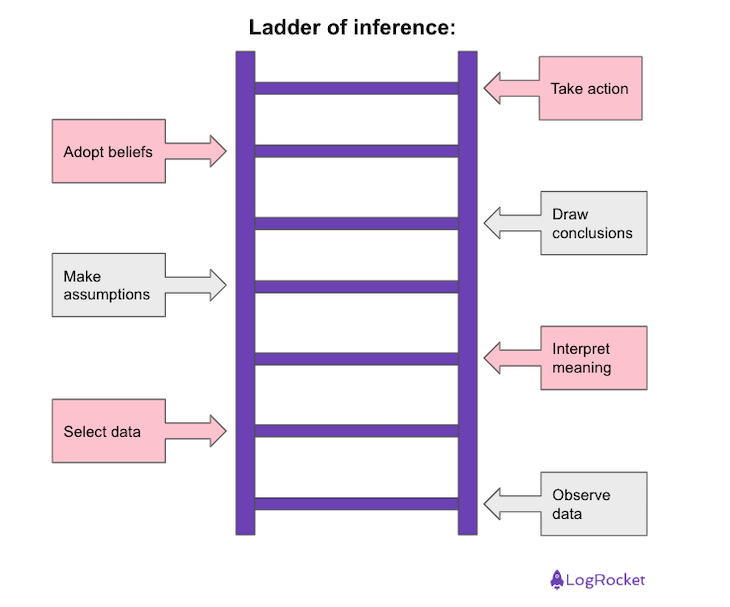Making good decisions is the cornerstone of product management. However, the path to making a good decision is often marked with obstacles like a lack of information or unconscious biases. If a product manager isn’t mindful, they could jump to conclusions based on assumptions and limited data.

By using the ladder of inference, a product manager can evaluate the thoughts behind their decision-making process and determine its validity.
In this article, you will learn what the ladder of inference is, the seven ladders that make it up, and how to use it in context.
The ladder of inference is a tool you can use to evaluate whether your thought process is based on reality or an assumption. It has seven rungs, with each step symbolizing a phase of your thought process. As you climb each rung of the ladder, you develop a conclusion and action plan.
The ladder of inference can also be a great tool for justifying your reasoning. If you know your conclusions are based on accurate data, and not your assumptions, then you are in an easier position to explain your recommended course of action.
Chris Argyris, known as the co-founder of organization development, developed the initial model of the ladder of inference. It was later expanded upon by Peter Senge. The ladder of inference allows product managers to challenge their assumptions and interpretations.
By doing so, product managers can avoid jumping to conclusions or using ineffective data. Since one rung affects the next rung, it’s crucial to examine the thoughts behind every step and ensure it’s based on reality.
There are slight variations in the ladder of inference, but you’ll find the seven rungs generally follow these categories:

The first (bottom) rung of the ladder of inference focuses on observing reality and facts. This type of data is usually available to everyone. It includes what people say, their body language, the internet content you read, and statistical data.
It’s extremely difficult to process every piece of data you come across, so this rung involves selecting which data to analyze. This is usually a subconscious process, but it may also be a conscious decision to selectively choose what data to ignore or not.
Based on your experience, perception, and biases, assign meaning to the selective data you analyzed. It essentially helps you add context to the data. This rung is subjective to the individual and may not be based on reality.
At the middle point on the ladder, a person will start making assumptions based on the meaning they gave the data. Since the previous rung is subjective, the assumption may not be an accurate viewpoint.
Based on your contextual meaning and assumptions, a person will conclude why something happened. This is where a person could jump to conclusions and ignore alternative viewpoints or explanations about the data.
Conclusions are transformed into beliefs. Depending on how you made assumptions and conclusions, these beliefs may or may not be valid. These beliefs may shape your future judgments and decisions.
In the ladder of inference, people will find themselves looping between rung two (selective data) and rung six and continuously reinforcing biased perceptions, and acting on limited information. This is known as a reflexive loop.
The last step is to take action based on what you believe. This might be based on assumptions instead of the facts of the situation.
As you can see, the ladder of inference has a connection to unconscious biases. These biases can have a large impact on most of these rungs. By using the ladder of inference, a product manager can check their thinking process and reject any unconscious biases.
The ladder of inference isn’t meant to be used as a way to make good decisions but as a way to evaluate your thought processes. Eliminating unconscious biases and assumptions is crucial to making good decisions. The ladder of inference can help with identifying and removing them.
When using the ladder of inference:
When you’re making decisions, it’s helpful to train yourself to reference the ladder of inference. Then you can adjust your thought process accordingly. Here are a few questions to ask yourself while you make decisions:
Sometimes it’s necessary to go back down the ladder and reevaluate your thought process. Consider why you developed those thoughts. You may realize you’re missing data or need to adjust your reasoning. Once you’ve gathered additional information or considered your assumptions, you can move back up the ladder with better reasoning.
Oftentimes, we tend to forget or ignore important information. Gathering actionable data is crucial to ensuring you’re making good decisions. You might want to consider taking the following actions to collect data:
While the ladder of inference focuses on your thought process, it’s important to ensure other people on your team understand your thoughts. This can help with their own decision-making process and help avoid conflict.
There are a few different ways a product manager can apply the ladder of inference in their work. Here’s a scenario of how a ladder of inference could be implemented:
Scenario — One of your team members is constantly missing deadlines
A product manager may go through this thought process:
If you use the ladder of inference to determine the validity of your decision, you may realize that you lack key information. For example, there was no direct communication between you and the team member on why deadlines were missed.
Were they unrealistic? Or is the team member facing personal issues? By stopping to gather more information, you can adjust your decisions to better suit the situation.
Besides these scenarios, you may also want to use the ladder on inference in situations like:
The ladder of inference isn’t meant to be a tool for making good decisions. Rather it’s designed to demonstrate the thought process of an individual, especially in terms of how people reinforce unconscious bias.
By being aware of the process, product managers can evaluate their thinking and remove any biases from their decisions. Removing these assumptions can help a product manager make better decisions.
Product managers can use the ladder of inference to confirm their decisions are based on facts. If they’re not, then they can go back down the ladder and alter their assumptions or gather more data.
Good decisions are based on accurate information and require you to remove biases and expand your perspective. Make sure you have enough data to glean actionable insights. Otherwise, you risk making the wrong decision or jumping to conclusions.
Featured image source: IconScout

LogRocket identifies friction points in the user experience so you can make informed decisions about product and design changes that must happen to hit your goals.
With LogRocket, you can understand the scope of the issues affecting your product and prioritize the changes that need to be made. LogRocket simplifies workflows by allowing Engineering, Product, UX, and Design teams to work from the same data as you, eliminating any confusion about what needs to be done.
Get your teams on the same page — try LogRocket today.

A practical five minute revenue estimation method to help product managers compare ideas, drop low impact features, and prioritize smarter.

A practical guide for PMs who want to stop being bottlenecks, delegate smarter, and lead teams effectively with a clear ownership framework.

Stop letting unreliable data block features. Treat data as inventory to track quality, ownership, and ship with confidence.

Learn why slide decks slow teams down and explore better tools like whiteboards, PRDs, and prototypes to improve collaboration and alignment.